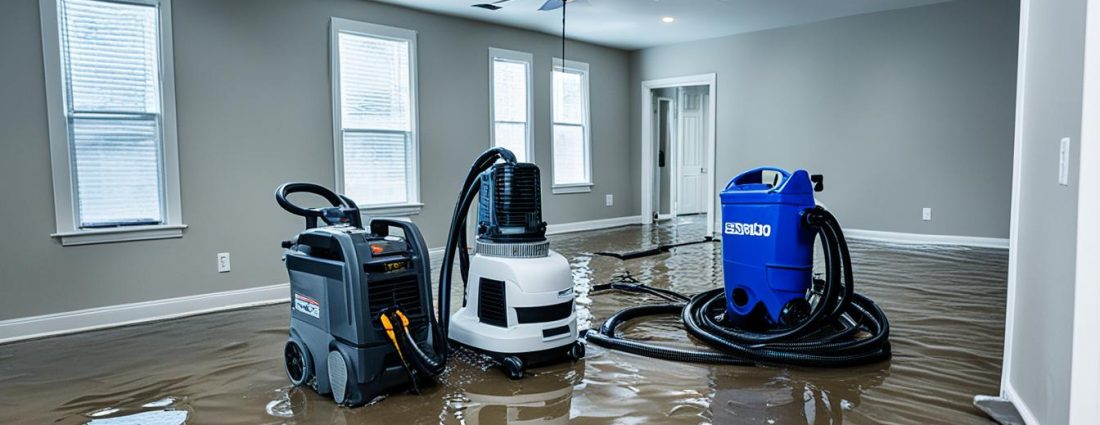Ever wondered how long water damage takes to fully dry? Homeowners often look for a clear timeline after floods, burst pipes, or leaks. Usually, small areas might dry in about 72 hours. But bigger spaces need more time and work.
The quicker you act, the faster the repair. It’s key to know that even if it looks dry, drying and fixing can take weeks.
Key Takeaways
- Water damage restoration timelines can vary significantly based on the size and severity of the affected area.
- Small rooms may dry within approximately 72 hours under optimal conditions.
- Larger areas require an extended drying period due to more significant water absorption and damage.
- Swift response to water damage—within the first hour—can reduce overall repair time.
- The full water damage drying process, including restoration efforts, might take several weeks.
Understanding Water Damage
Water damage is a common problem in many homes. Homeowners need to know the different causes and types of water damage. This knowledge helps in identifying, mitigating, and restoring damage efficiently.
Common Causes of Water Damage
Water damage comes from natural and man-made sources. Hurricanes, flooding, and leaks from appliances are common causes. Malfunctioning HVAC units and clogged gutters also contribute to water damage.
Identifying the cause of water damage early is key. It helps prevent costly repairs and long-term problems.
Types of Water Damage
Water damage is divided into types based on its source and severity. Acute damage, like from rainwater or burst pipes, needs quick action to stop further damage. Long-term damage, from condensation or humidity, may progress slowly but is still destructive if ignored.
Knowing the types of water damage is crucial. It helps in taking the right steps to control and restore damage.
Factors That Influence Drying Time
The time it takes to dry water damage depends on several key factors. Each one can greatly impact how fast and well the water damage is fixed. Knowing these factors helps set realistic goals and plan for a successful fix.
Size of Affected Area
The size of the area hit by water damage is very important. Larger areas take longer to dry because water spreads out more. Smaller areas might dry faster if handled right. The depth and spread of water also matter a lot.
Type of Building Materials
The materials in a building can speed up or slow down drying. Porous materials like drywall and carpet hold onto moisture longer. Non-porous materials like tile or concrete dry faster. The longer water stays, the harder it is to fix, possibly needing mold removal and repairs.
How Long Does Water Damage Take to Dry Out?
Water damage usually takes about 72 hours to dry out per room. But, many things can change this time. The moisture level and the building’s structure are key factors.
Also, the weather outside affects how fast water damage dries. Humidity and temperature are important in this process.
The first step of drying is just the start. After that, there’s more work to do. This includes fixing the structure, removing mold, and sometimes asbestos.
This extra work can make the whole process take up to a month. It shows how complex and detailed water damage restoration can be.
Effective Drying Methods
Water damage can be tough to handle, but using the right drying methods is key. Different techniques work based on the damage’s severity and available resources.
Air Drying
Air drying is a basic method to improve air flow in a property. Open windows and doors to let fresh air in. If that’s not possible, use high-powered fans to move air and dry surfaces faster.
Use of Drying Equipment
For better drying, specialized equipment is needed. Dehumidifiers help lower humidity, making it drier. Also, condensation dryers and fans improve air flow. Heaters can raise the temperature, speeding up moisture evaporation.
Professional Restoration Services
For severe water damage, professional restoration services is vital. Experts use top-notch equipment like water extractors and advanced dryers. They also take safety steps to avoid more damage and protect people.
Conclusion
Finalizing water damage recovery is a detailed process. It starts with finding the source of the water. This is the first step to stop more damage.
After that, drying out the area is crucial. The time it takes can vary a lot. It depends on the size of the area, the materials, and how quickly you act.
Fixing water damage involves several important steps. Using air dryers and special equipment like dehumidifiers is key. Professional services also play a big role. They make sure everything is dry, clean, and safe.
Restoring a property to its original state is the main goal. This means making sure it’s clean and safe for people to live in again. This careful process ensures no moisture is left behind, stopping mold and damage.
By following these steps carefully and using the right tools and experts, you can fix water damage well. This makes sure your property is safe and you’re happy with the results.

